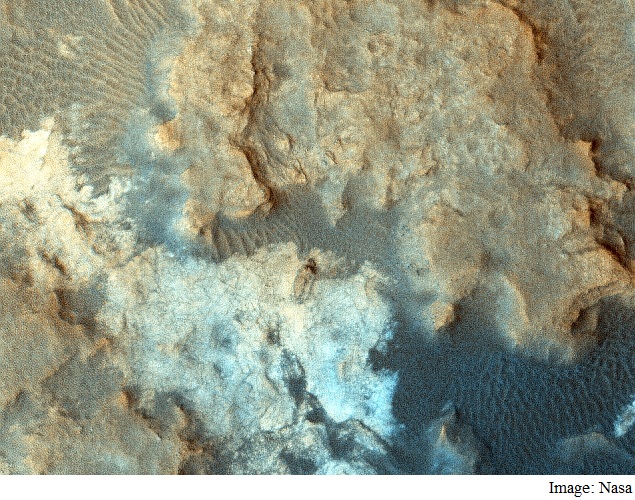- Home
- Science
- Science News
- Researchers Find Fresh Evidence for Groundwater on Mars
Researchers Find Fresh Evidence for Groundwater on Mars

Researchers have found fresh evidence of groundwater presence on the Red Planet.
Scientists investigated the Equatorial Layered Deposits (ELDs) of Arabia Terra in Firsoff crater area of Mars to understand their formation and potential habitability, according to a new study published in GSA Bulletin.
On the plateau, ELDs consist of rare mounds, flat-lying deposits and cross-bedded dune fields.
The scientists interpreted the mounds as smaller spring deposits, the flat-lying deposits as playa, and the cross-bedded dune fields as aeolian.
They wrote that groundwater fluctuations appear to be the major factor controlling ELD deposition.
They noted that the ELDs inside the craters would likely have originated by fluid up-welling through the fissure ridges and the mounds, and that lead to evaporite precipitation.
The presence of spring and playa deposits points to the possible presence of a hydrological cycle, driving groundwater upwelling on Mars at surface temperatures above freezing, according to lead researcher Monica Pondrelli from Italy-based International Research School of Planetary Science.
Pondrelli and colleagues wrote that such conditions in a similar Earth environment would have been conducive for microbial colonization.
As a basis for their research, Pondrelli and colleagues produced a detailed geological map of the Firsoff crater area.
The new map includes crater count dating, a survey of the stratigraphic relations, and analysis of the depositional geometries and compositional constraints.
They noted that this ELD unit consists of sulphates and shows other characteristics typical of evaporites such as polygonal pattern and indications of dissolution.
Catch the latest from the Consumer Electronics Show on Gadgets 360, at our CES 2026 hub.
- Samsung Galaxy Unpacked 2025
- ChatGPT
- Redmi Note 14 Pro+
- iPhone 16
- Apple Vision Pro
- Oneplus 12
- OnePlus Nord CE 3 Lite 5G
- iPhone 13
- Xiaomi 14 Pro
- Oppo Find N3
- Tecno Spark Go (2023)
- Realme V30
- Best Phones Under 25000
- Samsung Galaxy S24 Series
- Cryptocurrency
- iQoo 12
- Samsung Galaxy S24 Ultra
- Giottus
- Samsung Galaxy Z Flip 5
- Apple 'Scary Fast'
- Housefull 5
- GoPro Hero 12 Black Review
- Invincible Season 2
- JioGlass
- HD Ready TV
- Laptop Under 50000
- Smartwatch Under 10000
- Latest Mobile Phones
- Compare Phones
- Honor Win RT
- Honor Win
- Xiaomi 17 Ultra Leica Edition
- Xiaomi 17 Ultra
- Huawei Nova 15
- Huawei Nova 15 Pro
- Huawei Nova 15 Ultra
- OnePlus 15R
- Asus ProArt P16
- MacBook Pro 14-inch (M5, 2025)
- OPPO Pad Air 5
- Huawei MatePad 11.5 (2026)
- Xiaomi Watch 5
- Huawei Watch 10th Anniversary Edition
- Acerpure Nitro Z Series 100-inch QLED TV
- Samsung 43 Inch LED Ultra HD (4K) Smart TV (UA43UE81AFULXL)
- Asus ROG Ally
- Nintendo Switch Lite
- Haier 1.6 Ton 5 Star Inverter Split AC (HSU19G-MZAID5BN-INV)
- Haier 1.6 Ton 5 Star Inverter Split AC (HSU19G-MZAIM5BN-INV)












